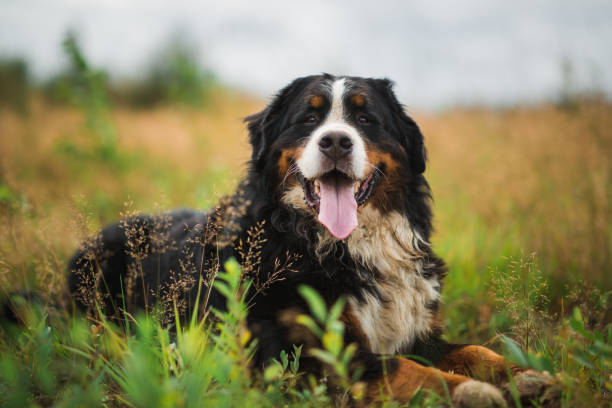The ancestors of the Bernese Mountain Dog most likely arrived in Switzerland around 2000 years ago with the Roman invasion. The Roman soldiers needed the Molossians they brought with them as guard dogs to protect their camps and supplies from attackers.
Characteristics
- The breed has its origins in Switzerland
- FCI (FCI Group 2, Section 3, Standard No. 45)
- good draft dogs, confident, intelligent
- prone to joint problems, HD, elbow dysplasia
- very good wakefulness
- popular family dog
- little hunting instinct
- Life expectancy 7 years +
Origin Bernese Mountain Dog
When the invaders later retreated, these dogs were simply left behind and then crossed with the local sheepdogs. As a result, the dogs were better able to cope with the difficult weather conditions in the Alps, and these crossings also made them a little more peaceful.
Use

The Bernese Mountain Dogs were mainly used as team dogs for the carts of the herdsmen and basket weavers. They also served as laborers on the farms, helping to drive cattle and guard the flocks. However, since they have a very friendly nature by nature, they were not so well suited as guard dogs for house and yard.
On market days, however, they always pulled their owners’ carts loaded with hand-woven baskets or milk products into the cities. Since the interest of dog lovers and breeders turned to other breeds such as the well-known and very popular St. Bernard but also imported dogs, the Bernese Mountain Dog was on the verge of extinction in the middle of the 19th century. There simply was no coordinated breeding program for this breed. In 1892, the Swiss dog researcher Franz Schertenleib began searching for the last specimens of these dogs.
After he had his first successes in the district of Durrbach near Bern, he was encouraged to search the rest of the country for dogs of this ancient breed. He found support in his efforts from Professor Albert Heim in Zurich, so the Bernese Mountain Dog owes its comeback to these two men.
The dogs they collected initially had different local or descriptive names such as “Vieräugli” (four eyes), “Gelbäckler” (yellow cheeks), “Käser-Hunde”, “Ringgit”, “Blässli” or, as the most common name, “Durrbächler”. In 1907 the Bernese Mountain Dog Club was founded in Switzerland. In 1910, 107 of these dogs were judged by Albert Heim at a show in Bern. Although many dogs had no proof of their ancestry, three-quarters of the dogs received a certificate that they were suitable for breeding.
This is how the Bernese Mountain Dog has ultimately stabilized again and saved from extinction. The American AKC recognized the breed in 1936, and Canada followed suit in the 1970s. Only in England has the breed remained quite rare so far. Unfortunately, in the 1930s there was a movement among breeders to breed the breed more aggressively in order to make them into a sort of guard dog. The result was that some animals had very light eyes and even cleft noses were found in isolated cases.
Fortunately, these breeding attempts were not crowned with success and were discontinued. In the meantime, the Bernese Mountain Dog has not only found a great number of fans in its homeland, but it is also extremely popular worldwide, not only because of its attractive appearance but above all because of its character traits.
In all probability, the Bernese Mountain Dog originated from the connection between livestock guardian dogs based in Switzerland and Molossers, which were carried by Caesar’s legions during the invasion of Switzerland over 2000 years ago. The Romans used their dogs as guard dogs to protect camps and supplies. Later, the Bernese Mountain Dogs were used as draft dogs. They pulled small carts loaded with dairy products and baskets on market days.
In the middle of the 19th century, the Bernese Mountain Dogs were almost completely extinct. St. Bernard was the more popular dog at the time.

It’s not easy to overlook the Bernese Mountain Dog because of its size. From time to time, however, the animal seems to have the impression that it is not being noticed enough. It sometimes sits on people’s feet, leans against them, or shows its sympathy with paws on the human shoulder.
The Dürrbächler or Bernes Mountain Dog, as it is alternatively called, is a family dog and people-oriented through and through. He needs closeness in order to be able to live happily. Not every two-legged friend likes being so close to a big dog.
Education
Fortunately, with patience, consistency, and expertise, the training measures for the Bernese Mountain Dog are regularly successful. Unwanted habits, such as skipping, must be eliminated from the start; before they take on awkward shapes due to the size of the dog.